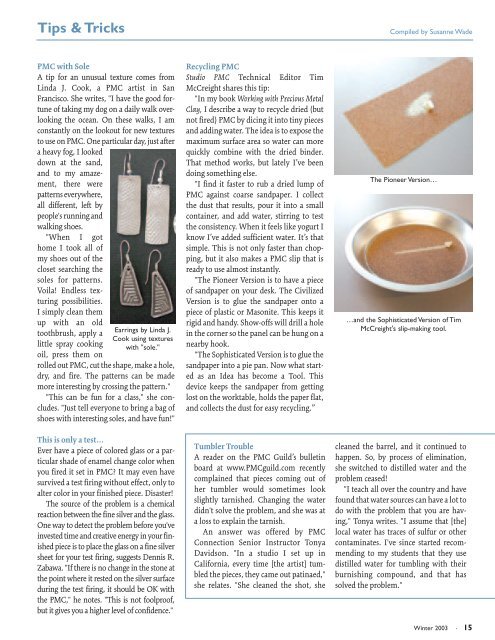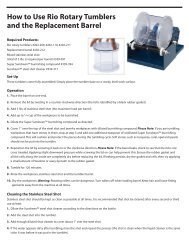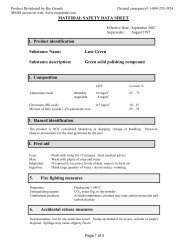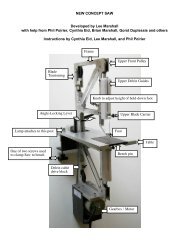Studio PMC - Rio Grande
Studio PMC - Rio Grande
Studio PMC - Rio Grande
- No tags were found...
You also want an ePaper? Increase the reach of your titles
YUMPU automatically turns print PDFs into web optimized ePapers that Google loves.
Tips & TricksCompiled by Susanne Wade<strong>PMC</strong> with SoleA tip for an unusual texture comes fromLinda J. Cook, a <strong>PMC</strong> artist in SanFrancisco. She writes, "I have the good fortuneof taking my dog on a daily walk overlookingthe ocean. On these walks, I amconstantly on the lookout for new texturesto use on <strong>PMC</strong>. One particular day, just aftera heavy fog, I lookeddown at the sand,and to my amazement,there werepatterns everywhere,all different, left bypeople's running andwalking shoes."When I gothome I took all ofmy shoes out of thecloset searching thesoles for patterns.Voila! Endless texturingpossibilities.I simply clean themup with an oldtoothbrush, apply alittle spray cookingoil, press them onEarrings by Linda J.Cook using textureswith "sole."rolled out <strong>PMC</strong>, cut the shape, make a hole,dry, and fire. The patterns can be mademore interesting by crossing the pattern.""This can be fun for a class," she concludes."Just tell everyone to bring a bag ofshoes with interesting soles, and have fun!"This is only a test…Ever have a piece of colored glass or a particularshade of enamel change color whenyou fired it set in <strong>PMC</strong>? It may even havesurvived a test firing without effect, only toalter color in your finished piece. Disaster!The source of the problem is a chemicalreaction between the fine silver and the glass.One way to detect the problem before you'veinvested time and creative energy in your finishedpiece is to place the glass on a fine silversheet for your test firing, suggests Dennis R.Zabawa. "If there is no change in the stone atthe point where it rested on the silver surfaceduring the test firing, it should be OK withthe <strong>PMC</strong>," he notes. "This is not foolproof,but it gives you a higher level of confidence."Recycling <strong>PMC</strong><strong>Studio</strong> <strong>PMC</strong> Technical Editor TimMcCreight shares this tip:"In my book Working with Precious MetalClay, I describe a way to recycle dried (butnot fired) <strong>PMC</strong> by dicing it into tiny piecesand adding water. The idea is to expose themaximum surface area so water can morequickly combine with the dried binder.That method works, but lately I’ve beendoing something else."I find it faster to rub a dried lump of<strong>PMC</strong> against coarse sandpaper. I collectthe dust that results, pour it into a smallcontainer, and add water, stirring to testthe consistency. When it feels like yogurt Iknow I’ve added sufficient water. It’s thatsimple. This is not only faster than chopping,but it also makes a <strong>PMC</strong> slip that isready to use almost instantly."The Pioneer Version is to have a pieceof sandpaper on your desk. The CivilizedVersion is to glue the sandpaper onto apiece of plastic or Masonite. This keeps itrigid and handy. Show-offs will drill a holein the corner so the panel can be hung on anearby hook."The Sophisticated Version is to glue thesandpaper into a pie pan. Now what startedas an Idea has become a Tool. Thisdevice keeps the sandpaper from gettinglost on the worktable, holds the paper flat,and collects the dust for easy recycling.”Tumbler TroubleA reader on the <strong>PMC</strong> Guild’s bulletinboard at www.<strong>PMC</strong>guild.com recentlycomplained that pieces coming out ofher tumbler would sometimes lookslightly tarnished. Changing the waterdidn't solve the problem, and she was ata loss to explain the tarnish.An answer was offered by <strong>PMC</strong>Connection Senior Instructor TonyaDavidson. "In a studio I set up inCalifornia, every time [the artist] tumbledthe pieces, they came out patinaed,"she relates. "She cleaned the shot, sheThe Pioneer Version……and the Sophisticated Version of TimMcCreight's slip-making tool.cleaned the barrel, and it continued tohappen. So, by process of elimination,she switched to distilled water and theproblem ceased!"I teach all over the country and havefound that water sources can have a lot todo with the problem that you are having,"Tonya writes. "I assume that [the]local water has traces of sulfur or othercontaminates. I've since started recommendingto my students that they usedistilled water for tumbling with theirburnishing compound, and that hassolved the problem."Winter 2003 · 15
















